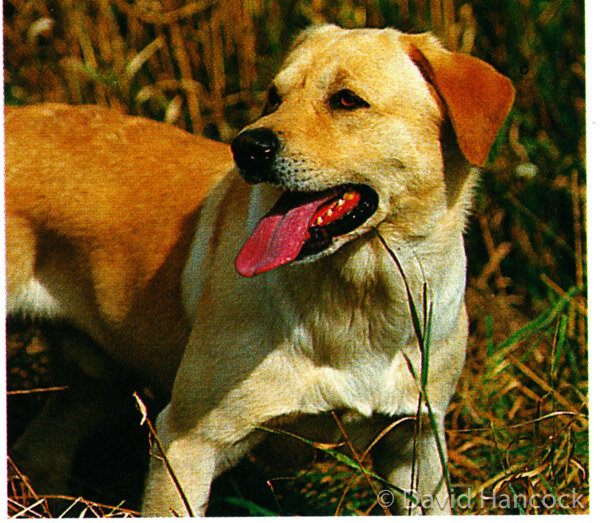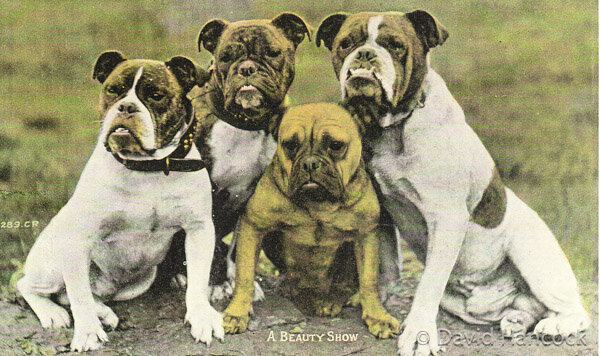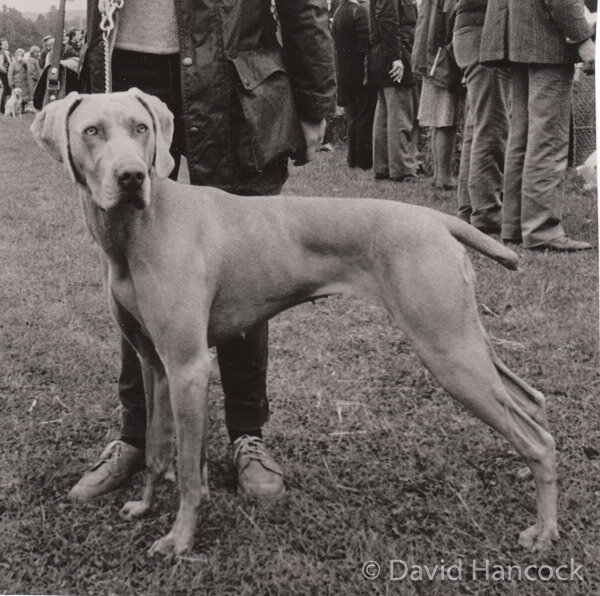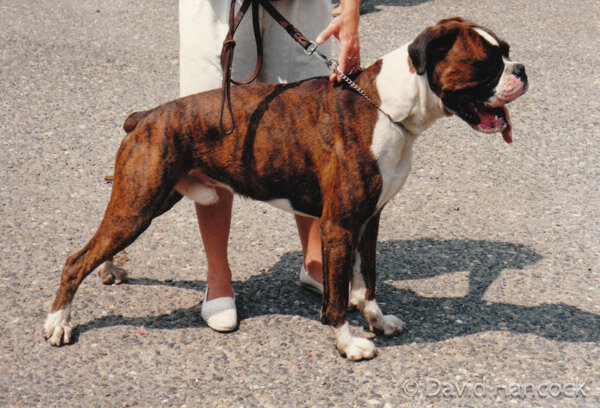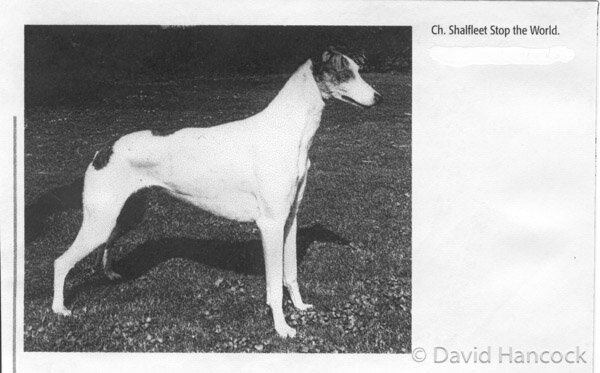1135
PUTTING PERFORMERS AHEAD OF POSEURS
By David Hancock
One of the less satisfactory aspects of the purebred dog industry in breeds that still work is the tiny contribution to the gene pool from the top working dogs. In the retriever world, the early dogs nearly always had field trial champions in their five-generation pedigree. Nowadays with well over 60,000 retrievers being newly registered with the Kennel Club each year only a very small percentage have that feature. Gundog experts who take the view that if the top dogs are good then there is little wrong with the breed are not living in the real world. It is illuminating too to note that the only group of sporting dogs still earning their keep in the field and whose breeders still register their stock with the KC is the gundog group. Racing Greyhounds, hounds of the packs and working terriers do not feature in KC lists. Working sheepdogs never have. Of the pedigree dogs bred each year the show-ring poseurs vastly outnumber the field performers. Soundness has been replaced by flashiness. The whims and fancies of humans have triumphed over the basic needs of the dog – soundness and ability to function in their breed’s task.
In every decade, in the world of the pedigree dog, the faddists are at work, sadly in far too many breeds. Sporting dogs, like the Setters, were once famed for their lung power; now they are mostly slab-sided in the chest, despite the evidence that such a structure enhances the likelihood of bloat. A Cocker Spaniel can, it appears win Best-in-Show at Crufts with ears which defy the breed standard. Oh, doesn't he know, I can hear the gundog gurus proclaim, that there is a division now between working and show gundogs? My response is two-fold: firstly, most of the gundogs taking part in the working tests I have judged were show-bred; secondly, I am prepared to bet that most readers of sporting magazines buy their gundog from a show breeder.
Fads may be passing indulgences for fanciers, but they so often do lasting harm to breeds. If they did harm to the breeders who inflict them, rather than to the wretched dogs who suffer them, fads would be more tolerable and certainly more short-lived. But what are the comments of veterinary surgeons who have to treat the ill-effects of misguided fads? In his informative book "The Dog: Structure and Movement", published in 1970, RH Smythe, himself a vet, wrote: "...many of the people who keep, breed and exhibit dogs, have little knowledge of their basic anatomy or of the structural features underlying the physical formation insisted upon in the standards laid down for any particular breed. Nor do many of them - and this includes some of the accepted judges - know, when they handle a dog in or outside the show ring, the nature of the structures which give rise to the varying contours of the body, or why certain types of conformation are desirable and others harmful." Those words may now be nearly half a century old but sadly they are truer now than then.
Having watched the judging at a recent Crufts on Working Group Day, I can see why such words were forthcoming. Having gone to my first dog show well over sixty years ago, I feel, with enormous concern, that things are getting worse rather than better. In his book, Smythe goes on to say that "...the same may sometimes be written regarding those whose duty it is to formulate standards designed to preserve the usefulness or encourage the welfare of the recognised breeds." Encouraging the welfare of the recognised breeds has to be the underlying mission of not just the Kennel Club, whom Smythe is pointedly criticising, but every breeder, every breed club and every judge officiating at dog shows.
Of course, it is deeply depressing to observe at Crufts, on gundog day, a Pointer win not just its breed ticket but the group one too when it displays not just a hackney action, forbidden in its breed standard, but over-extended hindquarters. The relentless pursuit of a muzzle-less Bulldog by contemporary breeders leads to distress in the dog. The vomer bone in this breed may be incomplete or more deeply notched at its front end than is desirable and this interferes with the suspension of the soft palate, giving rise to difficulty in breathing, especially in hot temperatures. This condition is often compounded by faulty development of the sphenoid bone, increasing the discomfort to the dog. The gundog breeds carry surprisingly heavy items of shot game in their mouths using their temporal muscles ahead of their masseter muscle. This results in a soft mouth. Marked cheek development is undesirable in any gundog breed if the soft-mouthed virtue is to be retained. But I see many Labradors with the jaw-width and cheek muscles of a Rottweiler. The Rottweiler has a strong jaw but for a different function from that of the retriever. I doubt very much if such a Retriever also displays a soft mouth. I worry too about some gundog breeds beginning to feature too deep a stop; cleft palates and very deep stops all so often go together. Why seek a feature which can harm the dog? This is faddism at work!
The jaws of so many breeds have fallen victim to thoughtless show points or perhaps breed points not thought through. Breeds ranging from the Poodle to the Chihuahua now have too narrow a jaw, too narrow that is to find space for the correct number of teeth. Conversely, broad-mouthed breeds like the Bulldog and the Boxer frequently display too many incisor teeth in both lower and upper jaw, as nature fills the unnatural width of mouth. Outward appearance impresses the judge but a faulty mouth does the possessor no good at all. Internal soundness is mainly a moral issue for breeders, but it also needs special attention from the more perceptive judges. Both the Bulldog and the Boxer are today’s equivalents of the ‘beissers’ or gripping dogs, used as seizers in the medieval hunt – both need powerful but sound jaws to achieve their legendary grip on their quarry.
We can stretch the jaw in width and length and the dog can still live a reasonably happy life. But when we seek to 'stretch' the hindquarters the consequences are much more worrying. We are then affecting the dog's ability to move as well as the best interests of its bone structure. Why does a show Greyhound need extensive angulation in the stifle when a successful racing Greyhound triumphs with relatively straight stifles? Why should a German Shepherd Dog in the 1980s suddenly need different hindquarters from all its ancestors? Why should the Weimaraner need its hind-feet positioned further back than the other 'hunt, point and retrieve' breeds? A passing whim, or fad, can soon become a breed feature! This would be a breed feature quite unlike the classic type of each breed, and importantly, a distinct handicap in their field of work – agile service dog and athletic HPR.
Inequality between the length of the rear stride and the length of the front stride is producing ugly unsound movement in an ever-increasing number of breeds as the contemporary fad for hyper-angulation in the hindquarters gathers more and more momentum. In the Dachshund, with this disrupted coordination, the hind feet have difficulty remaining in harmony with the front ones – and this, combined with inflexibility in the spine, produces a failure to synchronise in the hind-quarters. In soundly constructed dogs, sufficient angulation in the hindquarters and adequate length in the tibia enables the hock to flex and the hind foot to advance beneath the body enough so that balance is maintained. The side effects of excessive angulation in the hindquarters of a number of pedigree breeds are increasingly manifesting themselves. Why then is it becoming almost 'de rigueur' in breeds like the Boxer, the Dobermann, the show Greyhound, the Great Dane and the show Whippet? The Boxers that I saw in Germany in the late 1960s were far sounder than the ones I see in today’s show rings. Their hindfeet were much more forward - right up under the croup. This fad never occurred when these breeds were bred to function!
In every animal walking on four legs the force derived from pressing the hind foot into the ground must be transmitted to the pelvis at the acetabulum, and onwards to the spine by way of the sacrum. In over-angulated dogs the locomotive power is directed to an inappropriate part of the acetabulum. In addition, so as to retain the required degree of rigidity of the joint between the tibia and the femur, other muscles have to come into use. In the over-angulated hind limb, the tibia meets the bottom end of the femur at such an angle that direct drive cannot ensue. The femur can only transmit the drive to the acetabulum after the rectus femoris muscle has contracted, enabling the femur to assume a degree of joint rigidity when connecting with the tibia. This means that the femur rotates anticlockwise whereas nature intended it to move clockwise. Boxers should have great athleticism, immense stamina and considerable agility, not be handicapped by harmful exaggeration and limited by basic unsoundness. This is an admirable working dog not an experiment in anatomical engineering.
Excessive angulation in the hindquarters, with an elongated tibia, may, to some, give a more pleasing outline to the exhibit when 'stacked' in the ring. But, in the long term, it can only lead to anatomical and locomotive disaster. Such angulation destroys the ability of the dog's forelimbs and hindlimbs to cooperate in harmony in propelling the body. Yet I have heard it argued by breed specialists at seminars that it will increase the power of propulsion operating through the hindlimbs and on through the spine. If it did, the racing Greyhound fraternity would have pursued it with great vigour. Greyhounds were once bred to run – very fast! I have heard a dog show judge praise an over-angulated dog because it 'stood over a lot of ground'! So does a 'stretched limousine' but it requires a purpose-built construction to permit the luxury. Dogs deserve soundness in their physique in they are to lead a healthy life.
For those who care about dogs and love their breed, physical soundness, the ability of each dog to lead a happy life and the future of the breed thankfully matter more. Freud wrote that dogs love their friends and bite their enemies, quite unlike people, who have to mix love and hate in their object relations. Gundog men who are only interested in the health and soundness of the top field dogs display little love for a breed. It's about time the working gundog fraternity ran their own studbook, gave thought to breed type and soundness and funded health schemes for working gundogs. With coursing banned and greyhound racing dying out, the Greyhound is now at the mercy of the show ring fanciers. Stand by for bigger hounds, with upright shoulders and that ‘stretched limousine’ hindquarter construction; goodbye functional breed!







